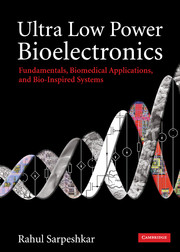Book contents
- Frontmatter
- Contents
- Acknowledgements
- Section I Foundations
- Section II Low-power analog and biomedical circuits
- Section III Low-power RF and energy-harvesting circuits for biomedical systems
- Section IV Biomedical electronic systems
- Section V Principles for ultra-low-power analog and digital design
- 21 Principles for ultra-low-power digital design
- 22 Principles for ultra-low-power analog and mixed-signal design
- Section VI Bio-inspired systems
- Section VII Energy sources
- Bibliography
- Index
- Epilogue
- References
22 - Principles for ultra-low-power analog and mixed-signal design
from Section V - Principles for ultra-low-power analog and digital design
Published online by Cambridge University Press: 02 December 2010
- Frontmatter
- Contents
- Acknowledgements
- Section I Foundations
- Section II Low-power analog and biomedical circuits
- Section III Low-power RF and energy-harvesting circuits for biomedical systems
- Section IV Biomedical electronic systems
- Section V Principles for ultra-low-power analog and digital design
- 21 Principles for ultra-low-power digital design
- 22 Principles for ultra-low-power analog and mixed-signal design
- Section VI Bio-inspired systems
- Section VII Energy sources
- Bibliography
- Index
- Epilogue
- References
Summary
If you shut the door to all errors, truth will be shut out.
Rabindranath TagoreIn this chapter, we present ten general principles for ultra-low-power analog and mixed-signal design. We shall begin by comparing the paradigms of analog computation and digital computation intuitively and then quantitatively. The quantitative analysis will be based on fundamental relationships that dictate the reduction of noise and offset with the use of power, area, and time resources in any computation. It shall reveal important tradeoffs in how the power and area resources needed for a computation scale with the precision of computation in analog versus digital systems. From these results, we shall discuss why, from power considerations, there is an optimum amount of analog preprocessing that must be performed before a signal is digitized. If digitization is performed early and at high speed and high precision, as is often the case, the power costs of analog-to-digital conversion and digital processing become large; if digitization is performed too late, the costs of maintaining precision in the analog preprocessing become large; at the optimum, there is a balance between the two forms of processing that minimizes power.
There are detailed similarities between power-saving principles in analog and digital paradigms because they are both concerned with how to represent, process, and transform information with low levels of energy. We shall itemize and discuss several of these similarities.
Information
- Type
- Chapter
- Information
- Ultra Low Power BioelectronicsFundamentals, Biomedical Applications, and Bio-Inspired Systems, pp. 651 - 694Publisher: Cambridge University PressPrint publication year: 2010
